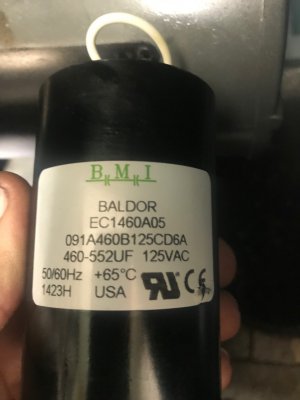-
Welcome back Guest! Did you know you can mentor other members here at H-M? If not, please check out our Relaunch of Hobby Machinist Mentoring Program!
You are using an out of date browser. It may not display this or other websites correctly.
You should upgrade or use an alternative browser.
You should upgrade or use an alternative browser.
Capacitor
- Thread starter Hutch
- Start date
- Joined
- Feb 2, 2013
- Messages
- 3,627
discharge capacitor, remove the wiring from the capacitor.
get analog ohm meter.
test meter by shorting leads, they should show continuity
place one lead on each terminal of the capacitor
the needle should raise if the capacitor is good, faulty if the needle doesn't move
get analog ohm meter.
test meter by shorting leads, they should show continuity
place one lead on each terminal of the capacitor
the needle should raise if the capacitor is good, faulty if the needle doesn't move
Last edited:
- Joined
- Jul 10, 2013
- Messages
- 1,190
Another test is a physical test. You see cracks and/or burnt areas especially on the terminal end, and there is sometimes what looks like something that leaked out. Chances are the cap started leaking electrically and got too hot and is no good.
- Joined
- Feb 1, 2015
- Messages
- 9,616
Hey, guys.
Is there a way to test this?
How do I know if it's bad?
Thank you.
You can get a fairly good idea of the capacitance by charging to a known voltage and shorting with a high value resistor while measuring the time until the voltage drops to 37% of the initial value . The time to reach 37% is equal to the product of the capacitance in microfards and the resistance in megohms. Charging to 12 volts, a 460 mfd capacitor and discharging through a 100KΩ resistor to 4.4 volts should take 46 seconds.
One factor to consider would be the input resistance of the voltmeter. This can be factored in by just shorting the capacitor with the voltmeter. It is possible to calculate and correct for the resistance of the meter.
- Joined
- Jun 17, 2019
- Messages
- 12
Without researching it the cap pictured is probably a polyester film with metal foil, there are two failure modes, open and short. Measure across the terminals with an ohm meter, if you get a low reading, ohms, tens of ohms the cap is shorted. If you get an overload (really an overrange) reading he cap is open. If the cap is good you will see a low resistance, kilo ohms then the reading will migrate to higher readings as the cap charges, eventually, depending on your meter and the size of the cap it may stabilize in the mega ohm area or overload, beyond the upper limit of the meter scale, this is the meter interpreting the charging current as a resistance. The right way to check, measure the capacitance with the cap function of a multimeter then check the cap insulation resistance with a Megger or similar high resistance meter which most people don't have.
- Joined
- Jul 29, 2014
- Messages
- 2,737
Ha, you guys are funny. You could also put it across a known inductor and check resonant frequency. Or, simply check by putting it in a circuit, any circuit and noting whether the voltage across it is proportional to the integral of the current flow.
Nothing to it, really.
Nothing to it, really.
- Joined
- Feb 17, 2013
- Messages
- 4,406
I've often used an analog volt (ohm) meter to do a basic go-nogo test on capacitors. You can use a digital meter if it has a bar-graph scale on the display. Otherwise, the decay is generally too fast for the numerics to be of any use.
Then a coupla years ago I saw an interesting DVM at Radio Scrap. It wasn't very expensive, so I bought it, because it included a capacitance measurement function (second option on the ohms scale). Seems to work pretty well. I have no idea if they're still available (ebay?), but the nomenclature on mine is "Radio Shack Cat. No. 2200075, 42-Range Digital Multimeter." On the front it says "Radio Shack, T-RMS Digital Multimeter." Unlike a lot of their products, it does not say "Micronta" anywhere.
Then a coupla years ago I saw an interesting DVM at Radio Scrap. It wasn't very expensive, so I bought it, because it included a capacitance measurement function (second option on the ohms scale). Seems to work pretty well. I have no idea if they're still available (ebay?), but the nomenclature on mine is "Radio Shack Cat. No. 2200075, 42-Range Digital Multimeter." On the front it says "Radio Shack, T-RMS Digital Multimeter." Unlike a lot of their products, it does not say "Micronta" anywhere.


